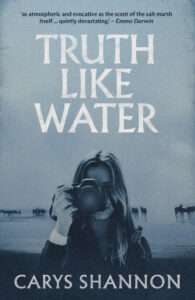
 In its first chapter, you could be fooled into believing that Carys Shannon’s debut novel, Truth Like Water, is written firmly in the model of Welsh noir – a paint by numbers mystery novel, or even a crime thriller plagued with pathetic fallacy, stormy skies and seas. But Shannon has taken the winning formulas found in genre fiction and imbued them with such depth of character and sense of place that the result is the makings of a bestseller.
In its first chapter, you could be fooled into believing that Carys Shannon’s debut novel, Truth Like Water, is written firmly in the model of Welsh noir – a paint by numbers mystery novel, or even a crime thriller plagued with pathetic fallacy, stormy skies and seas. But Shannon has taken the winning formulas found in genre fiction and imbued them with such depth of character and sense of place that the result is the makings of a bestseller.
On the third anniversary of her mother’s passing, Catrin spots a mysterious girl near the site where she found her mother’s dead body. Catrin is too trapped in her own thoughts to pay the girl any mind but when the girl goes missing, Catrin feels guilt and regret that her nonchalance may mean the girl has met the same watery fate her mother did – a death that never made sense to her in the first place: ‘She knew the tides and would never have risked getting caught out.’
We quickly learn it’s not just Catrin struggling to come to terms with death. In Truth like Water, everyone is grieving something. The grief hangs heavy over the unnamed town like the clouds hang over the estuary that is the centre of the book’s troubles. Catrin grieves her mother. Dai and Bev grieve their son. Catrin says she and her father are ‘nothing more than ghosts to each other now’; the pervasive grief that smothers the relationships of the living left behind. All of the peripheral characters grieve in their own ways – for time lost, relationships, potential, and decisions they’ve made. But in every situation the grief gives way to something else – a spider’s web of secrets entrapping the whole village. The missing girl is the catalyst that sets our protagonist on a mission to break it.
In order to truly get to the heart of the story, Shannon meticulously paints a picture of what it is to be working class, what it is to be poor, what it is to be from a rural community, what it is to be part of a real community in a time when many people have all but forgotten this. It’s here that the book really comes alive. Shannon is another of Wales’ contemporary writers who excellently paint, from experience or imagination, the dichotomy of village or small-town life. The people who will gossip about you in one breath and give you the clothes from their back in the next.
Though the place the book takes place in is never defined beyond ‘a small estuary village on the Welsh coast’, in her acknowledgements, Shannon describes this book as a ‘north Gower novel’. People often say that a first novel is by nature autobiographical, and some of the characters, experiences and landscapes are so well detailed that they give colour to a rural Wales that I was unfamiliar with.
The relationships are intricately painted, and the way Shannon has chosen to do this is a masterclass in the difference between perspective and the narrative voice. Our protagonist is proud of the knowledge of the complex and dangerous estuary that was instilled in her by her mother ‘I know this place, every ditch and rut and river.’ But she doesn’t always understand people so well; misreading situations often, her self-admitted stubbornness mars her decision-making. We can see before she does that she’s got the wrong impression of both of her parents, as well as Dai, the man she loves like a second father. It’s a reminder that 20-year-olds are bullish and naïve – I found myself questioning her choices and then chastising myself – you were young once, too.
And there are themes that we all understand, regardless of the setting. The push and pull of our hometowns, the tensions between parents and children, the people who will go against their nature to protect their own, the men who mask abuse as affection.
The book has hallmarks of a future bestseller or a successful TV adaptation. A classic story arc. A beautiful young female heroine with an internal conflict and external rage. A hint of romance. An adversary in the form of an incompetent policewoman. A loyal dog companion. A tide which serves as a metaphorical and actual sign of danger. But as a reader who writes (or a writer who reads) I’m not always as invested in the action as I am in the details: the language that build a sense of place or defines a character. Shannon is a real master of quiet signifiers; ‘two bags from the local supermarket’ mark someone out as an outsider, because he’s clearly not supporting the overpriced local shop. There are hundreds of these throughout the book: small glances, gestures – ‘He pats my hand as if I was one of the ewes’ – that can tell us more about the characters than many pages of prose would.
Shannon has made a canny choice in setting the book in the autumn of 1992. There are no mobile phones and no mention of computers, and the main character carries around an offer letter which she’s to sign and return. Her mother takes photos on a film camera and develops them in a dark room. It’s a reminder that such mysteries couldn’t unfold in a small village in quite the same way in 2025. The girl would have been spotted by someone, snapped on a mobile phone, and reported as behaving strangely on a Facebook group within ten minutes of appearing on the flats.
Though the book does sometimes give in to repetition and cliché – about artists needing to escape the confines of small communities, silver tides, dark glances and dark skies – all in all, it is an impressive debut.
At its core, Truth Like Water is a book about the lies we tell to protect each other, or ourselves. And in the end, the truth really is like water. It can wash away with the tides, but it always comes flooding back.
Jade E. Bradford is an author, communications and engagement professional and PhD researcher in Creative Writing. Her short fiction has appeared in Wasafiri, Breadfruit Magazine, and Rowayat. Her short story, 'Nine Night' was longlisted for the 2025 4th Estate and Guardian 4thWrite Prize, while 'Drifting' won the 2024 Breadfruit Magazine Prize. Her Young Adult short story 'An Embarrassment of Janets' was highly commended in the 2023 Faber FAB Prize for Children’s Literature.
Her non-fiction work has featured in Photoworks' Festival in a Box, Writers Mosaic, and across a range of digital platforms.
Jade is an alumnus of Literature Wales Representing Wales (2023/24), Black British Book Festival Writers on the Rise (2024), and Hay Festival’s Writers at Work (2025).